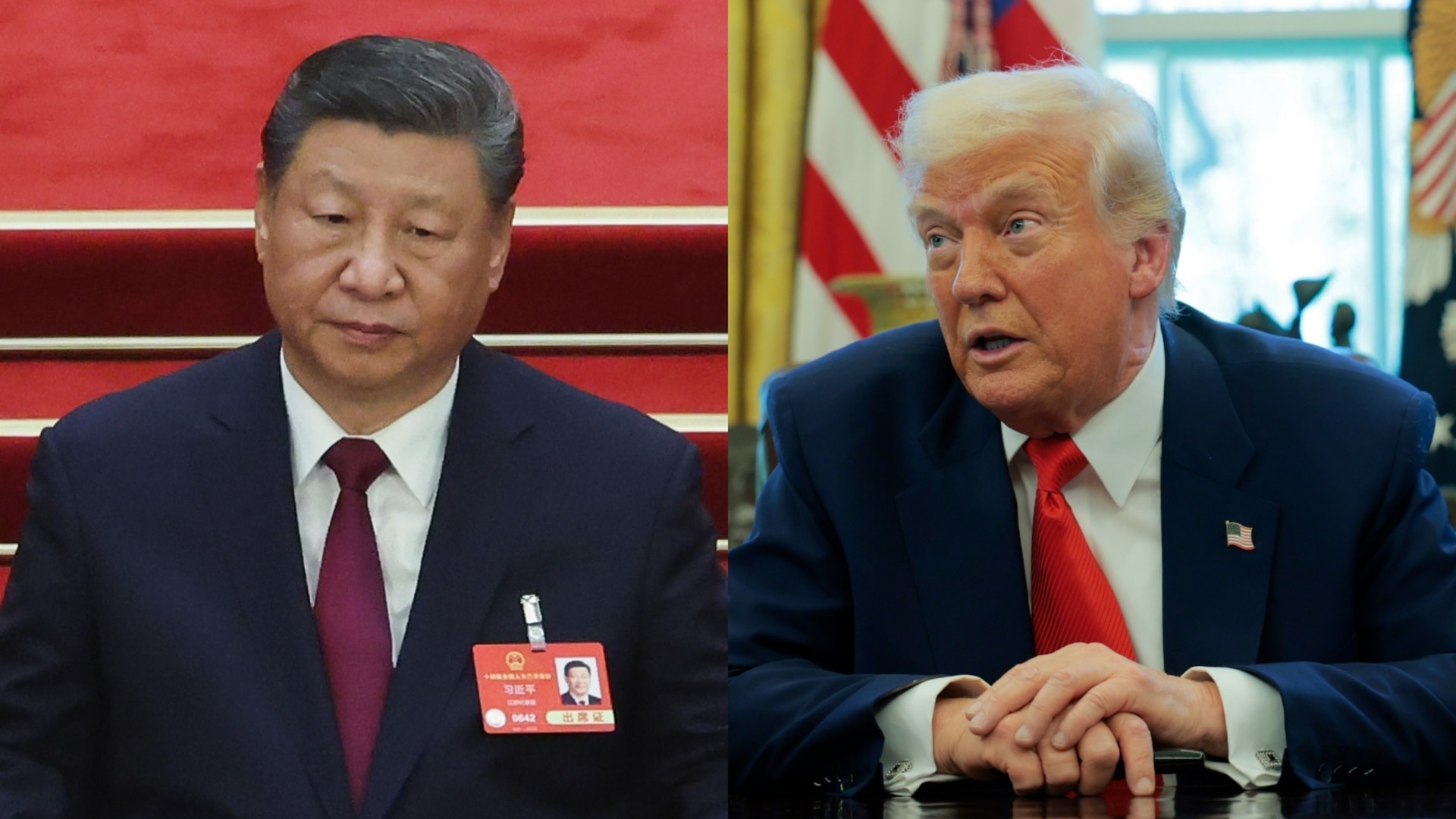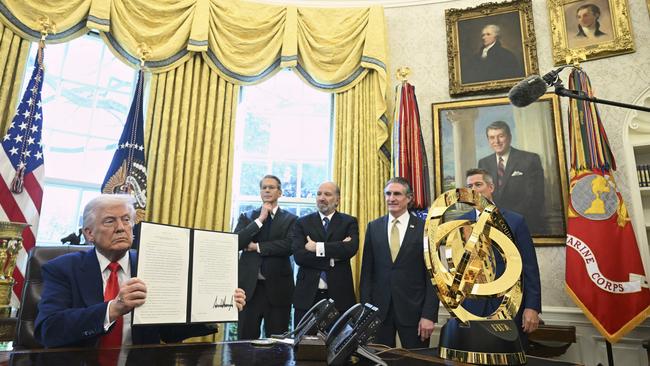Federal Reserve in spotlight amid sell-off in stocks and bonds
A sharp, simultaneous sell-off in stocks and bonds this week raises an obvious question — just how close is the US Fed to stepping in and protecting the US financial system?

Business
Don't miss out on the headlines from Business. Followed categories will be added to My News.
The sharp and simultaneous sell-off in US stocks and bonds this week and subsequent capitulation by US President Donald Trump raises an obvious question – just how close is the Federal Reserve to stepping in to protect the US financial system by buying bonds and or cutting interest rates as it did during the pandemic?
Any need to do so potentially abated somewhat after the “Trump put” was activated, albeit partially.
However, President Trump also dialled up his trade war against China with a 125 per cent tariff, which is effectively an embargo.
The rest of the world still faces a 10 per cent tariff and the prospect of reciprocal tariffs resuming in 90 days, barring successful talks with President Trump.

It still amounts to a major growth shock for the rest of the world and inflation shock for the US that’s probably not fully priced in by global markets at this point.
Investors are assuming that President Trump will continue to back down on tariffs. However, that’s by no means certain based on his form this year.
There’s also the risk of unintended consequences, like foreign central banks selling Treasuries.
The 10-year auction on Wednesday appeared to find very strong buying from foreign official institutions, but the bond market faces another test today with the 30-year auction on Thursday.
US bond yields have retreated significantly, with US 10-years at 4.27 per cent and 30 years at 4.675 per cent after spiking to 4.51 per cent and 5.02 per cent respectively this week.
But falls in stocks seemed to cause losses that forced leveraged accounts to sell bonds
There were reports of stress in the repo market, causing an unwinding of the “basis trade” – leveraged arbitrage between physical Treasuries and futures.
If stocks fall further and bonds are sold again, the Fed may be compelled to show its hand.
“The Fed’s officially on the political clock now — whether Powell wants to play ball with Trump is irrelevant,” SPI Asset Management’s Stephen Innes said.
“The bond market was teetering on the edge this week, and the Fed just got served a dose of reality that’ll be hard to ignore.
“Liquidity was drying up; volatility was bleeding into the plumbing, and bond market reflexivity was AWOL. That’s not a policy debate — that’s a flashing red warning light.
“I still don’t see five cuts, but I’d wager two or three are coming fast.
“Not because the data demands it, but because the market’s dictating it.”

Money market pricing now implies only a 16 per cent chance of the Fed cutting rates by 25 basis points at its next meeting in May, and about three rate cuts by December.
But on Tuesday, US rate cut pricing implied a better than even chance of the Fed cutting in May and a total of four rate cuts by December. Even that pricing may have been a bit light.
US investment bank Citi expects the Fed to cut in May or June as economic data weaken.
Ominously, the bank’s global head of commodities research, Max Layton, told clients on Tuesday to “refrain from buying and remain short risk-exposed commodities such as oil and base metals until the ‘Fed put’ or a material ‘Trump put’ kicks in, or until copper reaches $7,500 a tonne, or we see a major US shale or OPEC+ response, whichever is first.”
“We believe that it is entirely possible that the ‘Fed put’ (i.e. QE/rate cuts) occurs before a material ‘Trump put’ does (i.e. removing all reciprocal tariffs until revenues are given as tax cuts for low-middle income workers, while giving time for deal making with ‘reciprocal tariff’ nations,” he said.
In his view, any rallies this week on “minor trade deal headlines or delays to the imposition of the April 9 tariffs would provide opportunities to sell rallies.”
The 10 per cent universal tariff, imposed April 4, is “negative enough,” he added, while noting that US gas and gold should outperform other commodities in the near-term.
MFS co-chief investment officer of fixed income, Pilar Gomez-Bravo, says the Fed wouldn’t take emergency action on the basis of stock market weakness alone, even if the S&P 500 fell deep into a bear market.
In her view, the stock market would need to fall a long way before the Fed would cut rates because of equity drawdown, yet it could provide liquidity facilities to the financial system.
“Normally what happens when you have this rapid unwind in equity markets, or another asset class, some hedge fund gets caught off guard – you start having margin calls.
“If a large hedge fund goes under, like LTCM (Long Term Capital Management) or Archegos Capital Management, the Fed would have to step in to preserve liquidity in the financial system.

The S&P 500 dipped into “bear market” territory this week when it fell as much as 21.3 per cent from its record high, although it “only” fell 18.9 per cent on a daily close basis.
“Frankly, the big elephant in this room is China,” Ms Gomez-Bravoshe.
“If the US imposes asset freezes and sanctions on China, then you could have a significant impact on the global financial system, which hurts US fiscal sustainability and reserve currency status.”
“The risk is that this erodes into a much worse environment, in terms of China, and that could lead to unexpected consequences.”
Ms Gomez-Bravo said the biggest issue for sovereign wealth funds and central banks that have treasuries or invest in the US, is the threat comes from the rule of law.
“If you start thinking that institutional frameworks that have existed for many, many decades start being eroded, if you start thinking the Fed loses its independence, then that could trigger a much bigger unwind of Treasury exposures around the world.
“The way that plays is that the Fed would have to, at some point, react, and that’s when you see funding costs and yields coming down in the US.
“If this kind of erodes into a much bigger issue of being worried about rule of law in the US, or Fed independence, then I think that can trigger a little bit more of the exit for US Treasuries.
One thing to watch is the US dollar – normally it acts as a safe haven in times of severe stress in global financial markets, but that hasn’t been the case so far in this episode.
“You’re not seeing the US dollar outperform like you would have expected,” Ms Bravo-Gomez said.
If the US dollar starts to weaken from here, it could be a sign of bigger problems to come.
Originally published as Federal Reserve in spotlight amid sell-off in stocks and bonds



